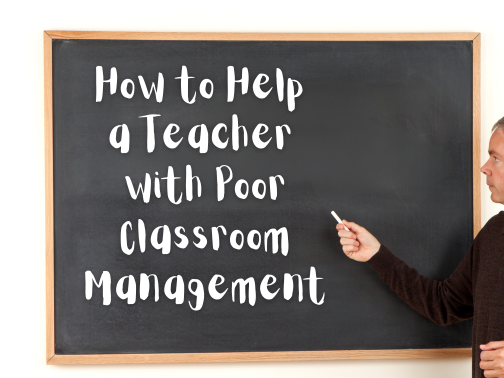Contents
Toggle
Meet David De’ Ath, co-founder, editor, and writer at Wonderful World English. With his extensive background as an English teacher, David provides valuable insights and practical tips on ESL for students and teachers alike.
Just like students, teachers have their own unique sets of strengths and weaknesses.
Navigating and managing a classroom well can come naturally to some, while to others, it can be quite a challenge.
Either way, classroom management is a crucial element of any good learning environment, and teachers can hone their ability to manage their students well.
I’ve worked with many teachers over the years, with some of their classes having immaculate behavior while others have struggled.
It can be a stressful aspect of teaching, and some teachers may even find themselves leaving a career they worked so hard to pursue.
Fortunately, there are some ways they can be helped and assisted in improving their classroom management skills.
To help a teacher struggling with poor classroom management, it is first vital to approach the situation with empathy and understanding. By offering advice and personal experience, you can build trust with the teacher. Each situation is unique, so it’s important to understand the root cause of the problem and then establish a plan of action to fix it.
As an experienced teacher, I have taught countless classes, with some even having over fifty students!
I can appreciate first-hand the importance of good classroom management, and today I aim to share some insights to help anyone having difficulty with this aspect of their teaching.
Whether this guide is for you, or someone you know, I hope fellow teachers can take inspiration and learn practical ways to manage their classes better.
Without further adieu, let’s jump in!

How to Help a Teacher with Poor Classroom Management
In order to help a teacher with poor classroom management, it’s important to know what makes for good classroom management.
A well-managed classroom has well-behaved students who are engaged and motivated to listen and learn.
There is a sense of fluidity where the students are involved and can collaborate well.
Good classroom management will breed a positive learning environment conducive to a better learning experience for everyone involved.
Students in a well-managed classroom will be more likely to achieve academic success and have more confidence.
A poorly managed classroom, on the other hand, can be a very chaotic setting that breeds stress and anxiety.
Students may begin to disrespect their teacher and avoid focusing on their studies.
Some big indicators of a poorly managed classroom are consistently disruptive students, frequent distractions, and a general lack of structure.
It can be a horrible experience for those who want to learn and the teacher, who will spend most of their energy trying to manage their class instead of actual teaching.
Teachers may have poor classroom management skills because they lack experience, have limited resources, or feel inadequately supported.
It’s important to show empathy with these teachers and, if they are willing to accept it, offer them assistance to help them overcome the difficulties of poor classroom management.
Let’s look at the two major steps to help a teacher improve their classroom management skills:
1. Offer Empathy and Support
First and foremost, when assisting a teacher who struggles with classroom management, it’s important to approach the situation with a level of understanding.
Teaching can be very demanding, and a teacher may be dealing with many challenges both in and out of the classroom.
Every teacher has had difficult classes to manage at some point, and we all have stories and examples of when we needed to apply certain strategies to keep a class under control.
If a fellow teacher is struggling, approach them and tell them they are not alone.
Offer some examples of times when you needed to improve a class’s behavior.
This will allow you to build rapport and trust, which will help when offering support and advice.
By reaching out and expressing your concerns to a teacher who needs help, the process of helping them with their classroom management will begin.
It’s important to highlight your intention to help rather than criticize.
Offer constructive feedback and suggestions and emphasize your experiences to help guide a teacher to manage a classroom better.
If a teacher is struggling with aggressive students, check out the guide below!
Related Article: How to Manage Aggressive Behavior in the Classroom – Guide

2. Work Together
After reaching out and offering support, so long as the teacher welcomes your input, it is time to collaborate with them to identify specific problems.
Look at the problems in their classroom and determine why something is happening the way it is.
Is there a disruptive student or a set of students that won’t listen, or is the content of the lessons too easy or difficult?
Understanding the root cause of the unwanted behavior is crucial in developing a plan to tackle it.
Once the problems are understood, you can brainstorm potential solutions and develop a plan of action.
If necessary, involve other teachers and staff who can offer their support and expertise in improving the situation.
By collaborating with a teacher in need, you can help them feel more supported and build their confidence in dealing with the issues in their classroom.

3. Gather Resources
A huge bane of teachers is when they lack the right resources to teach a class effectively.
Without having the right materials, it can be far more challenging to manage a classroom.
Teachers can share resources such as books, art materials, games, and relevant props in order to keep their classes more fun and engaging.
Suppose a teacher is using an interactive whiteboard. In that case, their PPTs should be visually stimulating, and they would be wise to find accompanying materials such as videos and songs that can enhance the lesson.
Ensuring a teacher is adequately equipped will help them keep on top of their classroom management and keep their students motivated to listen and learn.
4. Establish a Routine
Classroom management will significantly improve when a class has a set routine, and everyone understands what is expected of them.
A teacher’s lesson should be linear and relevant, not random and unpredictable.
It can be effective to surprise students every now and then, but a class should not be all over the place in terms of structure.
Teachers need to communicate with their students and ensure they fully understand the classroom dynamic and that there will be consequences if they do not.

5. Apply Strategies
A struggling teacher may need to apply behavior management strategies in their classroom.
They should be encouraged to explore different techniques, such as positive reinforcement and applying classroom rules.
Good students should be rewarded for desired behavior as this can motivate badly behaved students to mimic the well-behaved ones.
Small treats such as stickers for younger students or candy for older ones can effectively improve classroom management.
Collaborate with a teacher in need to help them develop a plan to improve their classroom management skills.
The setting of rules should not be understated.
Check out the article below for some reasons and insights into the importance of classroom rules.
Related Article: Why Are Rules Important in a Classroom? – Teacher’s Answer
6. Promote Student Engagement
Another great and practical strategy is to have a struggling teacher promote student engagement in their lessons.
Offer them suggestions on how to make their classes more interactive and hands-on.
Students who are interested in the lesson’s content will be far more likely to behave.
One great way to do this is to set class projects individually or in teams.
Making a competition of it and rewarding the best work is a great way to improve general classroom management.
A classroom should also be neat, tidy, and well-organized.
Students will feel less inclined to stay organized if a classroom is messy.
Helping a teacher who struggles with this can effectively improve their classroom management skills.

7. Strengthen Teacher-Student Relationships
A positive relationship between teachers and students is fundamental in a well-managed classroom.
If the students respect and admire their teacher, they will be inclined to listen and behave.
A teacher should work to create an inclusive and welcoming environment where all students feel valued.
If a teacher struggles with this, help them establish rapport by showing genuine interest in their student’s lives and offering individualized attention.
Positive classroom culture is crucial to having a well-managed classroom.
Check out the guide below for some tips on how to build a positive classroom culture.
Related Article: How to Build a Positive Classroom Culture – Teacher’s Tips
8. Encourage Growth
Encourage a struggling teacher to engage in self-reflection and grow professionally.
Suggest attending workshops and joining communities that focus on classroom management.
If they seem apprehensive, you could offer to join them, encouraging them all the way.
Taking inspiration and insights from the wealth of knowledge available can significantly aid a teacher in managing a classroom well.
Keeping a journal or making progress reports can be great ways to monitor development and stay motivated.

Conclusion
Classroom management is a fundamental role of any teacher.
Students are far more receptive and focused when a classroom is managed well.
It improves motivation and reduces stress and anxiety for everyone involved.
Some teachers struggle with this aspect of teaching, and it can be difficult to behold.
If you know someone who is struggling with classroom management, you can reach out to them in a respectful and empathetic manner.
Please share your insights and stories on classroom management and help determine the root cause of their problem.
Once established, the two of you can establish a plan of action to improve their classroom management skills once and for all.
Remember that each situation is unique, and there is no ‘one size fits all’ approach.
By applying some of the steps in this guide, any teacher will be well on their way to improving classroom management.
We hope this has given you some insights and inspiration to help a teacher struggling with poor management skills.
Have a wonderful day!
Image Attribution: All images licensed via canva.com





